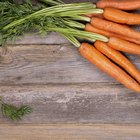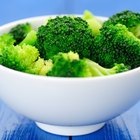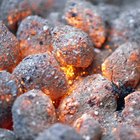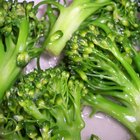
MASAHIRO MORIGAKI/amanaimagesRF/amana images/Getty Images
Cooking food using any method is going to have a negative impact upon its nutrients. The general rule of thumb is that the less time spent cooking, the fewer nutrients will be lost. The key element involved in loss of nutrients is heat. How much nutritional value a food loses during the cooking process is directly related to how long it is exposed to heat. While some exceptions may exist, this is true in relation to vegetables, fruits and meat.
Water Leaching
Cooking may not result in the loss of as much nutritious value as you might fear, according to WebHealthCentre.com. When it comes to loss of protein and minerals when cooking vegetables, the directive is to use less water to lessen the effect of leaching. The same source also recommends using the leftover water in gravies or sauces to retain the nutrients that have been leached.
Heating Canned Vegetables
Canned vegetables that have just been opened will retain their nutrients much better if you heat them up in the microwave or under low heat on the stovetop, according to the "American Dietetic Association Complete Food and Nutrition Guide." Canned vegetables have already been cooked, so the bigger problem is overcooking rather than undercooking them. The longer they are exposed to heat, the more nutrients will be lost, so microwave heating is the best method for retaining nutritional value.
Peels and Skins
“Foods that Harm, Foods that Heal” offers the very important reminder that many nutrients found in produce are contained within the skin or peeling. This concentration of nutritious value can instantly be lost when food preparation involves unpeeling the skin. The authors recommend that, unless the outer part of the produce has been coated with wax or pesticides, you cook the food with the skin intact and peel after boiling. This will allow the nutrients located in the peel to be absorbed into the interior of the fruit or vegetable.
Portion Size and Cutting
IDEA Health and Fitness recommends maintaining your food in as large a state as possible prior to cooking. Each slice through a piece of food means a loss of nutrients. The best way to keep all the vitamins and minerals intact in vegetables is therefore to either leave them uncut or cut them into large chunks. During the cooking process, use soft-edged tongs to turn over meat products instead of a fork, as the puncturing of a piece of meat can reduce the amount of nutrients.
Fluorescent Lighting and Produce
Part of the process of retaining as much of the original nutritional value of vegetables and fruits begins at the market where you buy the produce. “The Practical Encyclopedia of Whole Foods” advises you to avoid purchasing produce you plan to cook that has been stored under fluorescent lights. This type of illumination has the potential to create a chemical reaction that can significantly deplete nutrients well before you begin the cooking process.
Related Articles

Hydroponic Vegetable Nutrients Vs. ...

Nutritional Effects of Overcooking

Are the Nutrients Lost in Slow Cooking?

Does Boiling Fruits Destroy Vitamins?

If I Puree Raw Vegetables Will That ...

How to Freeze Carrots & Turnips

Ways to Cook Broccoli

Why Do Vegetables Go Limp?

How to Steam Vegetables in an Electric ...

The Impact of Cooking Broccoli

How to Preserve Rutabagas
Does Cooking Break Down Fiber?

How Does Infrared Cooking Work?

How Long Does It Take to Steam a Yam?

Nutrients for Steamed Broccoli
How to Thaw, Cook & Refreeze Vegetables

Can You Freeze Sweet Potatoes After ...
Maximum Storage Temperature of Canned ...

How to Steam Broccoli & Carrots With a ...

How to Steam Broccoli Without Making it ...
References
- "Compiling Data for Food Composition Data Bases"; Adjustments for Losses and Gains During Preparation; William Rand, et al.; 1991
- "Foods That Harm, Foods That Heal"; Theresa Lane, Ed.; 1996
- IDEA Health and Fitness Association; The Best Cooking Techniques & Utensils; Catherine Reade, M.S., R.D.; April 2002
- "The Practical Encyclopedia of Whole Foods"; Nicola Graimes; 2008
- "American Dietetic Association Complete Food and Nutrition Guide"; Roberta Larson Duyff; 2002
Writer Bio
Timothy Sexton's more than 10,000 articles have been published on sites ranging from USA Today to CareerAddict, from PopEater to TakeLessons.com. His writing has been referenced in books ranging from "The Reckless Life...of Marlon Brando" to "Brand New China: Advertising, Media and Commercial and from Scarface Nation to Incentive!"
Photo Credits
MASAHIRO MORIGAKI/amanaimagesRF/amana images/Getty Images